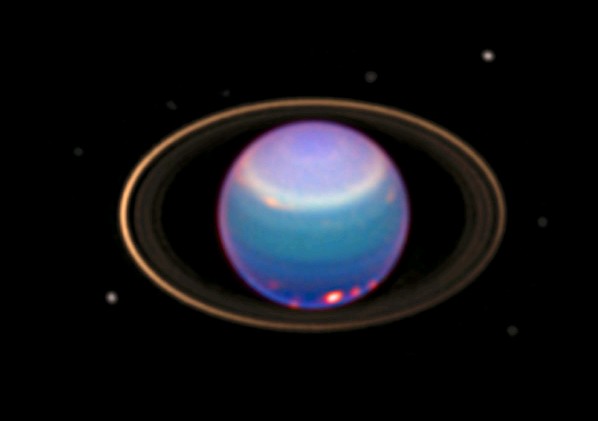Massive storms are caught erupting from Uranus – and the ‘monstrous’ jet streams are so huge they can be seen from Earth
- Uranus has a thick atmosphere with winds blowing at 560 mph (900 km/h)
- Its storms could engulf continents on Earth with temperatures at -220°C
- The planet’s strange tilt is the reason behind this bizarre weather system
- One feature, which resembles an iceberg peeled off an ice-shelf, is of particular interest to astronomers who are viewing the planet from Hawaii
Huge storms have been erupting on Uranus – and they are so enormous they can be easily seen using telescopes on Earth.
The swirling clouds and violent winds are being driven by massive bands of jet streams that can surround the entire planet.
Astronomers in Hawaii said they were ‘surprised’ by the bright storms they observed this week, including one that they described as ‘monstrous’.
 Massive storms on Uranus captured August 5 and 6, 2014 as seen by Keck Observatory in Hawaii. Astrononers said they were ‘surprised’ by the bright storms, particulary one that they described as a ‘monstrous’
Massive storms on Uranus captured August 5 and 6, 2014 as seen by Keck Observatory in Hawaii. Astrononers said they were ‘surprised’ by the bright storms, particulary one that they described as a ‘monstrous’Uranus boasts a thick atmosphere with winds blowing at 560 mph (900 km/h).
It has massive storms that could engulf continents on Earth, and temperatures in the -220°C (-360°F) range.
Scientists believe the planet’s strange tilt is the reason behind this bizarre weather system.
The Earth has seasons because the axis tilts, and the hemisphere tilted towards the sun gets more light than that the region tilted away.

But Uranus has an axis that runs almost parallel to the plane. It also spins backwards, compared to the other planets, making its tilt 98 degrees.
This causes 21-year-long seasons and unusual cold weather. For nearly a quarter of the Uranian year – equal to 84 Earth years – the sun shines directly over each pole.
‘We are always anxious to see that first image of the night of any planet or satellite, as we never know what it might have in store for us,’ said Imke de Pater, professor at UC Berkeley and team leader.
‘This extremely bright feature we saw on 6 August 2014 reminds me of a similarly bright storm we saw on Uranus’s southern hemisphere during the years leading up to and at equinox’.
‘Even after years of observing, a new picture of Uranus from Keck Observatory can stop me in my tracks and make me say Wow!’, said Heidi Hammel, a member of the observing team.
Since the 2007 equinox on the planet, Uranus’s northern pole has been coming into view, and the south pole is no longer visible.
The bright feature Professor de Pater refers to was known as the ‘Berg’, because it was visible just below the polar haze, and resembled an iceberg peeled off an ice-shelf.
The Berg oscillated in latitude between southern latitudes of 32 and 36 degrees since 2000, and perhaps dated back to the Voyager era in 1986.
The present storm is even brighter than the Berg. Its morphology is similar, and the team expects it may also be tied to a vortex in the deeper atmosphere.
While today we know more about Uranus’ amazing weather systems, when Voyager 2 went by in 1986 nothing much seemed to be happening.
As the hurricanes Iselle and Julio gain in strength near Hawaii, it will be interesting to see how the storms on another world also continue to evolve.

